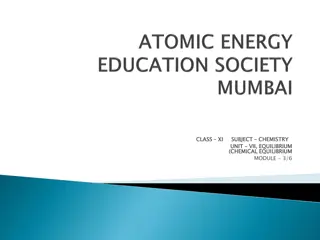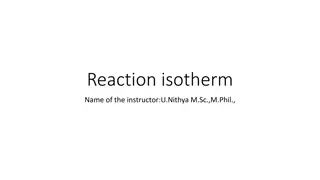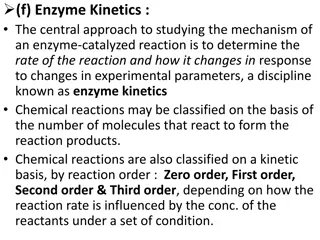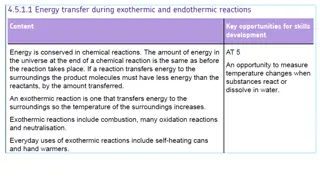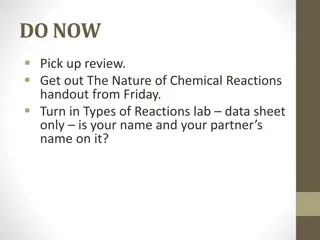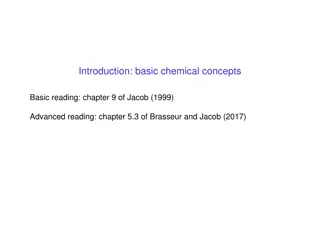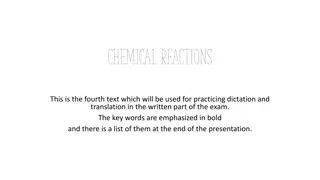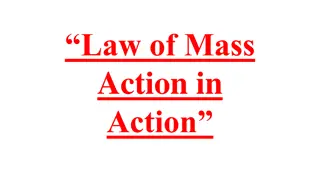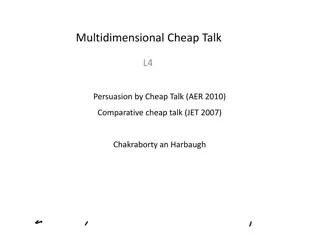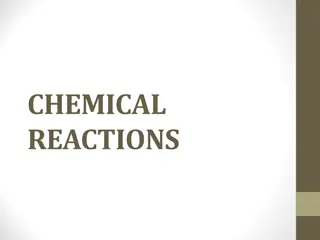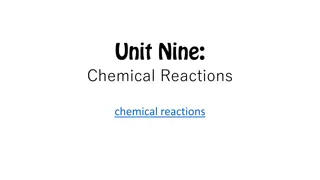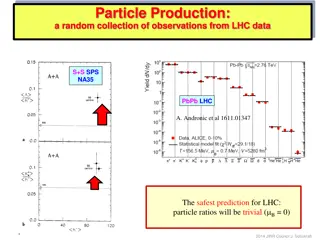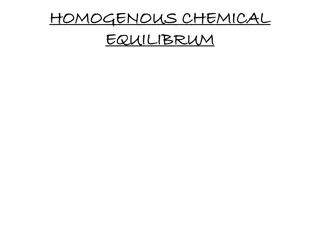Dynamic Equilibrium in Chemical Reactions
Explanation of reversible reactions, dynamic equilibrium, and the characteristics of equilibrium in chemical systems. Covers the concept of reversible reactions, dynamic equilibrium, rules for dynamic equilibrium, and examples to illustrate these concepts visually.
Download Presentation

Please find below an Image/Link to download the presentation.
The content on the website is provided AS IS for your information and personal use only. It may not be sold, licensed, or shared on other websites without obtaining consent from the author.If you encounter any issues during the download, it is possible that the publisher has removed the file from their server.
You are allowed to download the files provided on this website for personal or commercial use, subject to the condition that they are used lawfully. All files are the property of their respective owners.
The content on the website is provided AS IS for your information and personal use only. It may not be sold, licensed, or shared on other websites without obtaining consent from the author.
E N D
Presentation Transcript
Equilibrium *Reversible reactions may reach equilibrium instead of completely converting reactants to products. *Dynamic equilibrium is defined in terms of reaction rates and concentrations of reactant and product
Reversible reaction (Nat5). A reversible reaction is a reaction that can go both forwards and backwards +6H2O CoCl2 CoCl2.6H2O Blue - 6H2O Pink
Dynamic equilibrium Reactants Products e.g. - hydrogen and iodine reacting to form hydrogen iodide. H2(g) + I2(g) 2HI(g) The equilibrium can be arrived at from different starting points.
2HI H2 + I2 H2 + I2 2HI The position of an equilibrium does not depend on the starting position.
Dynamic equilibrium A reversible reaction is said to be at Dynamic equilibrium when: Rate of the forward reaction = Rate of the reverse reaction Rules for (dynamic) equilibrium: 1. The concentration of reactants and products remains constant. 2. The concentrations are not usually equal 3. The reaction has not stopped Note: equilibrium is reached in a closed system. This means no substances are added or removed.
Reversible Reactions e.g. Carboxylic acid + alcohol ester + water reversible reaction At the beginning of the reaction: Acid + alcohol react to produce ester and water As the reaction proceeds: acid + alcohol producing ester + water ester + water producing acid + alcohol Eventually: Rate of ester, water produced = Rate of acid, alcohol produced
Position of equilibrium In a Concentration vs Time graph, the amounts of substances become constant at equilibrium: concentration products reactants time Equilibrium At equilibrium the concentration of products and reactants remains constant.
Example Ethanoic acid + methanol methylethanoate + water When equilibrium is reached 33% reactants 67% products Equilibrium is said to lie to the right hand side (R.H.S.)
Equilibrium Reaction Rate Graphs concentration Equilibrium lies to L.H.S. Time Equilibrium Reactants Products
In a Rate vs Time graph, that the forward rate is large at first but steadily decreases, while the reverse rate starts at zero and steadily increases, until both rates are equal at equilibrium: Equilibrium constant Forward Rate equilibrium Backward Time
Altering Equilibrium Position *Chemists alter the position of equilibrium to increase product yield, by changing factors such as; concentration, pressure, Temperature. *The use of a catalyst ensures the same equilibrium is reached more quickly but does not increase product yeild. A catalyst has no effect on the position of equilibrium
Altering the Position of Equilibrium e.g. A + B C Rules: Equilibrium moves right; More products (C) are produced More reactants (A,B) are produced Equilibrium moves left;
Equilibrium A reversible reaction can reach equilibrium in a closed system. N2 + 3H2 2NH3 then it can remain at equilibrium forever unless the reaction conditions are altered. The effects of any changes are stated in Le Chatelier s Principle:
Le Chatelier's Principle If a chemical system at equilibrium experiences a change in total pressure, temperature or concentration, the position of equilibrium will shift to reduce the effects of the imposed change .
1.Concentration may alter the position of equilibrium
Changing Concentration Carboxylic acid + alcohol ester + water INCREASE CONCENTRATION of any REACTANT: Equilibrium moves to the right INCREASE CONCENTRATION of any PRODUCT: Equilibrium moves to the left Opposite will apply: DECREASE CONCENTRATION of PRODUCTS: Equilibrium moves to the right (and vice versa)
Increasing by addition of a substance. OR Decreasing by removal of a substance by precipitation (data book page 21) or by neutralisation (H+ /OH-)
Concentrationand equilibrium Experiment 1 1. To 1 test tubes add 5cm3 iron (III) chloride. Iron (III) ions are yellow. 2.Add potassium thiocyanate solution until the solution goes red i.e. iron thiocyanate ions form. 3.Dilute this solution with water to make up to 100ml. Divide between 6 test tubes equation: Fe 3+ + CNS - yellow (colourless) red [FeCNS]2+ The equilibrium position now lies in the middle, roughly equal amounts of both coloured ions are present.
Test Tube 1. Ions added Control Observations Reason 2. Fe 3+ Darker red 3. CNS Darker red 4. K+Cl- Turns yellow Goes colourless 5. Ag+NO3- 6. NaOH
1. Add Fe 3+ ions Add a few drops of iron (III) chloride. What happens? Higher Chemistry Eric Alan and John Harris Fe 3+ + CNS - [FeCNS]2+ yellow red Test tube B Fe 3+ ions are added. The equilibrium moves to use them up, favouring the forward reaction. The equilibrium moves right and the solution becomes deeper red.
2. Add CNS - ions Add a few drops of Potassium thiocyanate. What happens? Higher Chemistry Eric Alan and John Harris Fe 3+ + CNS - [FeCNS]2+ yellow red Test tube C CNS- ions are added. The equilibrium moves to remove these, favouring the forward reaction. The equilibrium moves right and the solution becomes more red
3. Add K+Cl- ions Add a few drops of Potassium chloride. What happens? Higher Chemistry Eric Alan and John Harris Fe 3+ + CNS - [FeCNS]2+ yellow red Test tube D Fe 3+ ions are removed by the addition of K+Cl- The equilibrium moves to replace this, favouring the reverse reaction The equilibrium moves left and the solution becomes yellow.
4. Add AgNO3 ions Add a few drops of silver nitrate. What happens? Higher Chemistry Eric Alan and John Harris Fe 3+ + CNS - [FeCNS]2+ yellow red Addition of AgNO3 (This forms a precipitate with CNS, thus removing CNS) The equilibrium moves left and the solution becomes colourless
Experiment 2 ICl + Cl2 ICl3 brown liquid yellow solid
ICl + Cl2 ICl3 brown liquid yellow solid Increasing the concentration of a chemical will cause the equilibrium to shift to use up the chemical. Increasing the concentration of chlorine will cause the equilibrium to move to use up the chlorine. The forward reaction uses up the chlorine so the equilibrium moves to the right producing more yellow solid and less brown liquid.
ICl + Cl2 ICl3 brown liquid yellow solid Decreasing the concentration of a chemical will cause the equilibrium to shift to replace the chemical. Decrease the concentration of chlorine and equilibrium will move to replace the chlorine. Equilibrium will move to the left (reverse reaction) producing more brown liquid and less yellow solid.
Examples: 1. Carboxylic acid + alcohol a. Acid added: b. Ester removed: c. Water added: ester + water 2. a. Ethene added: b. Sodium added (reacts with bromine); Br2 + C2H4 C2H4Br2 3. H2O H+ + OH- a. Water removed: b. Magnesium added (reacts with acid):
2.Temperature may alter the position of equilibrium
Remember Le Chatelier's principle states: The equilibrium will move to undo any change imposed upon it. Heating a reversible reaction at equilibrium shifts the reaction in the direction of the ENDOTHERMIC REACTION (more A + B produced) Cooling a reversible reaction at equilibrium shifts the reaction in the direction of the EXOTHERMIC REACTION (more product C produced)
Exothermic reaction A + B C + D + Energy - H Add heat -The reverse reaction (endo) absorbs heat. equilibrium moves to the left. The new equilibrium mixture contains more A and B Conc product Low temp High temp - favours reactants so less product formed. faster In an exothermic reaction; increasing temperature shifts equilibrium to the left.
Endothermic reaction Energy + A + B C + D + H Forward reaction is endothermic Increasing temperature shifts equilibrium to the right. High temp- favours rhs so more product formed. Conc product Low temp faster
Experiment N2O4 dinitrogen tetraoxide nitrogen dioxide (colourless) (dark brown) 2NO2 H +ve
N2O4 2NO2H +ve dinitrogen tetraoxide nitrogen dioxide (colourless) (dark brown) Increasing the temperature Equilibrium moves to lower the temperature. The forward reaction takes in energy so the equilibrium moves to the right Producing more NO2 , so the colour becomes darker. Decreasing the temperature Equilibrium moves to raise the temperature. The reverse reaction gives out energy so the equilibrium moves to the left producing more N2O4. The colour becomes lighter.
3.Pressure may alter the position of equilibrium
The pressure exerted by a gas is caused by the freely moving molecules bombarding the walls of the container. An increasein the number of molecules results in an increase in pressure, assuming the size of the container is kept constant. The system can reduce the pressure by reacting in such a way as to produce fewer molecules.
Changing Pressure N2(g) + 3 H2(g) 2 NH3(g) 1 volume 3 volumes 2 volumes 4 volumes Increase Pressure Volume decreases FOR GASES, an increase in pressure will cause the equilibrium to counteract this effect so shift to the side of lower volume to reduce the pressure. High pressures favour the side with less gas molecules.
Increase pressure: volume decreases 1. Equilibrium moves to side with lowest volume (right) 2. more NH3 produced Decrease pressure: volume increases 1. Equilibrium moves to side with largest volume (left) 2. More N2, H2 produced Note: 2 A (g) + B (g) 4 C (s) + D (g) + 3 E (aq) Reactants have largest volume Gases occupy much more space than solids or liquids
EXO Ex1. Br2 (l) + H2O (l) 2 H+ (aq) +Br-(aq) + BrO-(aq) ENDO A.Addition of bromine: B. Increase temperature: C. Addition of acid: ENDO Ex2. C2H4 (g) + H2O (g) C2H5OH (l) A.Remove ethanol: B. Decrease pressure: C. Decrease temperature:
Q. According to Le Chatelier how will increasing the pressure effect the following reaction: N2O4 colourless 1 mole, so fewer particles lowers the pressure 2 moles 2NO2 brown A. According to Le Chatelier, the position of equilibrium will move in such a way as to counteract the change. That means that the position of equilibrium will move so that the pressure is reduced again. This favours the side with the fewer gas molecules (which is N2O4).
4. Catalysts A catalyst would increase the rate of the forward reaction and the reverse reaction, therefore: dynamic equilibrium will be achieved quicker, However A catalyst has NO EFFECT on the position of equilibrium.
Summary Variable Action Effect on position of Equilibrium moves to opposite side Concentration increase moves to same side decrease Temperature increase moves in ENDOTHERMIC direction decrease moves in EXOTHERMIC direction moves to side with lowest volume of gas Pressure increase decrease moves to side with highest volume of gas No effect though equlibrium more rapidly attained Catalyst
Effect of chemicals not present in the equilibrium Dissolving chlorine in water produces the hypochlorite ion, ClO-, which has a bleaching effect. Cl2 + H2O 2H + + ClO- + Cl-
Effect of neutralisation Cl2 + H2O 2H + + ClO- + Cl- Adding an alkali will remove hydrogen ions from the equilibrium which will move to the right to replace them The bleaching effect will be increased.
Effect of precipitation Cl2 + H2O 2H + + ClO- + Cl- Adding silver nitrate will remove chloride ions from the equilibrium as the precipitate silver nitrate is formed. The equilibrium will move to the right to replace them so the bleaching effect will be increased.
Effect of acid Cl2 + H2O 2H + + ClO- + Cl- Adding an acid causes the equilibrium to move to use up H+ ions. The equilibrium moves to the left producing more toxic Cl2 This can be fatal and accidents caused by mixing bleach and acid are not unusual.
Equilibrium and Industry The laws of equilibrium are used by industrial chemists to increase the yield of products. e.g The Haber Process: EXO 3 N2 (g) + H2(g) 2 NH3 (g) ENDO Ammonia
Ammonia (NH3) is manufactured in the Haber process. Feedstocks are: 1. Nitrogen from the air 2. Hydrogen from natural gas Reaction conditions: Catalyst: Iron Temperature:450 C Pressure:200 atmospheres
The reaction is reversible, so as well as nitrogen reacting with hydrogen to make ammonia, the ammonia also breaks back down again into nitrogen and hydrogen. In most industrial situations a continuous process is used. This means that equilibrium which requires a closed system is never achieved.
The above process is carried out in industry: at a specific pressure at a specific temperature unreacted reactants are recycled continuously products are removed continuously a catalyst is used






